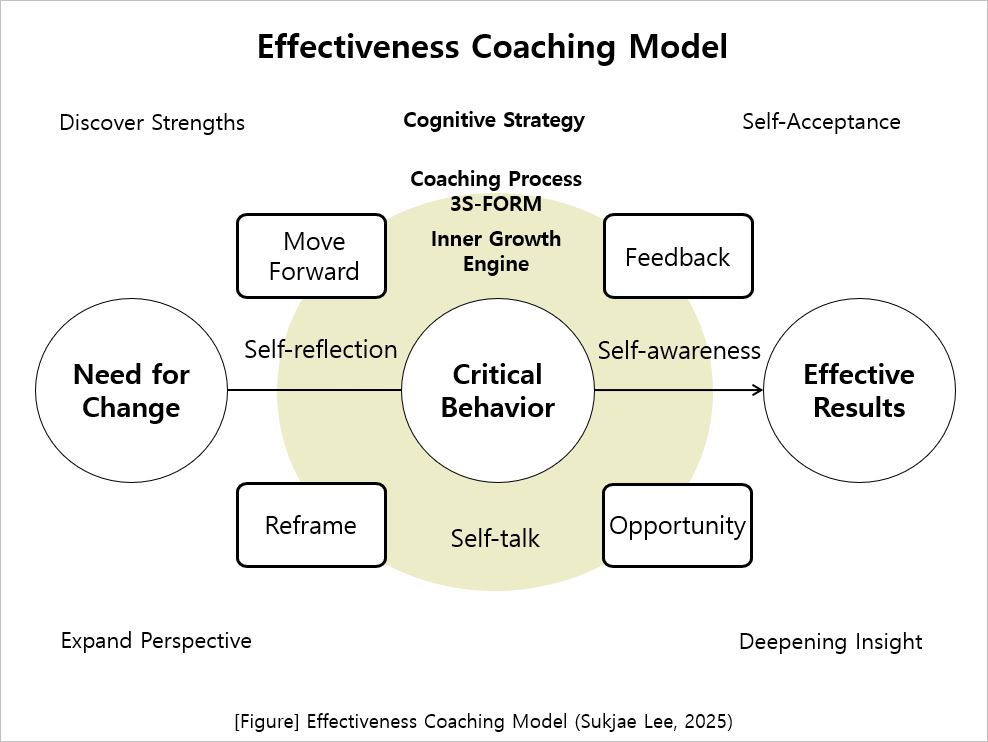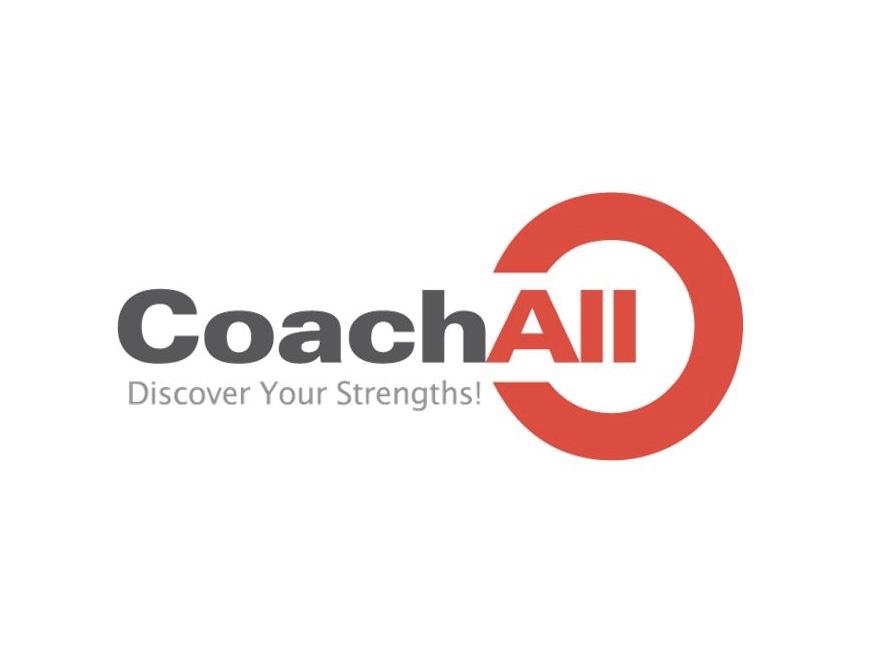| 일 | 월 | 화 | 수 | 목 | 금 | 토 |
|---|---|---|---|---|---|---|
| 1 | ||||||
| 2 | 3 | 4 | 5 | 6 | 7 | 8 |
| 9 | 10 | 11 | 12 | 13 | 14 | 15 |
| 16 | 17 | 18 | 19 | 20 | 21 | 22 |
| 23 | 24 | 25 | 26 | 27 | 28 | 29 |
| 30 |
- 코칭심리학
- 관점 코칭
- 효과성코칭
- 결정적 행동
- 증거기반코칭
- thinking partner
- 효과성 코칭
- 이석재 코치
- 원하는 결과
- 코칭 프레임워크
- 현장중심 코칭심리학
- 코칭심리학 공부방
- 경영심리학자의 효과성 코칭
- 효과적 리더십진단(ELA)
- Effectiveness Coaching Methodology
- 코치올
- 코칭방법론
- 떠도는 마음 사용법
- 효과성 코칭 모델
- 코칭심리학 시리즈
- 효과성 코칭 워크숍
- 씽킹 파트너
- 관점 전환
- 실행력을 높이는 코칭심리학 수업
- Coach Sukjae Lee
- 효과성 코칭 방법론
- 효과성코칭워크숍
- 효과성 코칭의 이론과 실제
- 생각 파트너 이석재
- 현징증심 코칭심리학
- Today
- Total
코치올
The Inner Growth Engine of Effectiveness Coaching 본문
Sukjae Lee, Ph.D.
Creator of the Effectiveness Coaching Methodology
2025. 11. 27
Growth Engine Driving Inner Development
It is important to distinguish between the general idea of coaching effectiveness (how well a coach performs) and the specific, trademarked Effectiveness Coaching Methodology, developed by Dr. Lee Suk-Jae. This methodology is a structured, evidence-based system designed to increase the probability of achieving desired results (Lee, 2014; 2020; 2024).
The Inner Growth Engine is the mechanism that transforms awareness, self-talk, and reflection into meaningful insight. It enables individuals to reframe experience, adjust behavior, and move toward more effective results.
1. Core Philosophy: What Is “Effectiveness”?
In this methodology, Effectiveness is defined as the degree to which desired results are achieved.
This differs from general coaching, which often focuses on broad personal growth or potential.
Premise:
People naturally seek effectiveness because it increases the likelihood of achieving what they want in life.
Goal:
Identify and strengthen the factors that influence result achievement.
Approach:
Integrate individual, team, and organizational effectiveness into one coherent system.

2. Behavioral Change Tool: The ABC Framework
To modify specific behaviors, Effectiveness Coaching uses the ABC Framework, grounded in behavioral science.
- A – Antecedent: What triggers the behavior? (Need for Change)
- B – Behavior: The specific action taken. (Critical Behavior)
- C – Consequence: The result (positive or negative). (Effective Results)
How it works:
The client examines a recurring issue using ABC. To change the desired C, the client typically must adjust A or B, rather than hoping outcomes change on their own.
This framework forms the foundation for conducting targeted behavioral analysis in the Effectiveness Coaching Model.
3. Central Framework: The 3S-FORM System
The core of the methodology is the 3S-FORM Model, which clearly separates the roles of the coachee and the coach.
The Coachee’s Role — “3S”: The Inner Growth Engine
Sustainable change requires the coachee to engage three internal cognitive processes:
- Self-Awareness:
Objectively recognizing one’s emotional state, thought patterns, and behaviors. - Self-Talk:
Using internal dialogue to motivate action and transform limiting thoughts into constructive ones. - Self-Reflection:
Analyzing actions and outcomes to learn, adjust, and deepen insight.
Together, these processes form the Inner Growth Engine—the mental system that interprets feedback, reframes situations, generates insight, and guides more effective behavior.
The Coach’s Role — “FORM”: The External Structure
While the coachee activates the 3S processes, the coach facilitates change using the FORM structure:
- F – Feedback:
Explore the current situation and help the client accept objective reality. - O – Opportunity:
Cultivate a growth-oriented mindset by framing challenges as opportunities. - R – Reframe:
Shift perspective to uncover new solutions and encourage commitment to action. - M – Move Forward:
Support execution, monitor progress, and reinforce successful patterns.
4. Why This Methodology Is Different
| Primary Focus | Increasing the probability of achieving results | Problem-solving or general goal-setting |
| Structure | Dual-process: Coachee uses 3S, Coach uses FORM | Coach leads a single structured conversation |
| Scientific Basis | Integrated behavioral science + effectiveness diagnostics (ELA/TEA/OEA) | General psychology or management theory |
This structured dual-process—internal engine + external guidance—creates a stronger mechanism for meaningful and sustained behavioral change.
References
Lee, Sukjae (2006). Develop 18 Core Leadership Competencies.
Lee, Sukjae (2014). Effectiveness Coaching by a Business Psychologist.
Lee, Sukjae (2019). Thought Revolution That Changes My Life.
Lee, Sukjae (2020). Coaching Methodology.
Lee, Sukjae (2020). How to Use a Wandering Mind.
Lee, Sukjae (2023). Field-Focused Coaching Psychology.
Lee, Sukjae (2024). Coaching Psychology Class for Boosting Execution.
Lee, Sukjae (2024). Thinking Partner.
Lee, Sukjae & Lee, Jongseo (2025). Perspective Shifting.
'3. 코칭심리연구 > 코칭심리 탐구' 카테고리의 다른 글
| The recent update of Effectiveness Coaching (0) | 2025.11.27 |
|---|---|
| The Inner Growth Engine of Effectiveness Coaching (0) | 2025.11.27 |
| Principles and Controversies in Perspective Shifting (0) | 2025.11.26 |
| 관점 취하기의 사회심리학 (0) | 2025.11.26 |
| 코칭에서 관점 전환의 중요성 (1) | 2025.11.26 |





